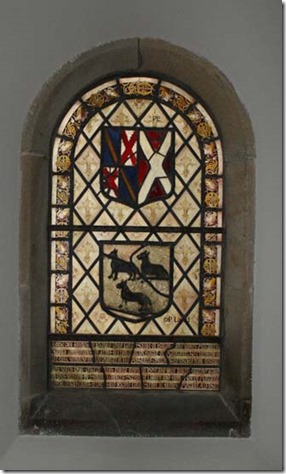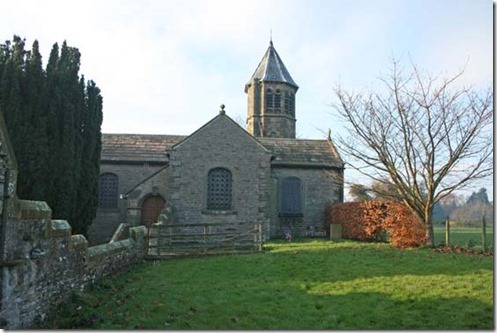Until 1865 the stained glass window which commemorated the Wensleydale contingent at the Battle of Agincourt in 1415 – led by the Third Lord Scrope of Bolton and James Metcalfe of Nappa – was in the East window of Aysgarth church. But then the Scrope (pronounced Scroop) family rescued it and took it to Ulshaw Bridge near Danby Hall and East Witton to be installed in St Simon and St Jude’s Roman Catholic church. Left: The window at St Simon and St Jude’s with the Scrope shield at the top.
When restoration work began on St Andrew’s, Aysgarth, in 1865 it was found that the walls were in such bad condition that the church had to be almost completely rebuilt. That commemorative window with the shields of the Scropes and the Metcalfes was found outside and carried away. When it was inserted into a window at St Simon and St Jude’s the inscription underneath explained that the shields were “rescued from destruction when (Aysgarth) church was pulled down and were placed together again …. by Simon Conyers Scrope of Danby and John Henry Metcalfe lineal descendants of the said Richrd (sic ) Lord Scrope & James Metcalfe AD 1897.”
By the early 19th century Danby Hall – just a mile from Ulshaw Bridge – had been replaced as the centre of Roman Catholic worship in Wensleydale by St Simon and St Jude’s. For centuries Roman Catholics had worshipped in secret because of the harsh penal laws instituted against them in the 16th century.
Until the reign of Elizabeth I the Scropes (or Scroopes as they were previously known) held such high offices in England as Lord High Chancellor, Chief Justice and Archbishop, as well as being earls, barons, Knights of the Garter and Wardens of the Marches. All that changed when the Scropes of Danby decided to remain Catholics after 1559 and so became known as recusants. During the years of penal law Catholics could be fined each week for not attending Anglican services; could not be commissioned into the army or navy; could not work as solicitors or become Members of Parliament; and could not buy, sell or own a horse worth more than £5.
“They had to keep their heads down, but they had a happy time as country gentlemen, farming and hunting. Danby Hall has had hard times, but they held on by the skin of their teeth, and it has never been sold,” the late Simon Scrope of Danby Hall told me in 2009. He added: “We were always Catholics. There has been an unbroken Catholic succession in this house since the Scroopes came here in 1561.”
In her book The Catholic Missions of Danby Hall and St Simon and St Jude Sally Doyle showed how the story of the Scropes was intertwined with the survival of Catholicism in Wensleydale. She wrote:
“The Scroopes achieved this by taking in and maintaining priests at risk of their own lives, and Danby became the heart of the small and secret community of Catholics in Wensleydale. Mass was covertly celebrated in a room in the tower on the east side of the house before it was safe to make a chapel in a large room on the ground floor, now the drawing room.”
Many of the priests were employed at Danby Hall under the aliases of grooms or gardeners and two hiding places (priest holes) were created in the Hall – one in the roof space of the tower and the other behind the hall fireplace.
“It is said that six, or even eight priests – the number is uncertain – are buried under the drawing room,” said Jane Scrope. “Well, I was brought up on that story,” commented her husband.
By the 18th century the penal laws had become unenforceable and so it was possible for Catholics to worship more openly even though they were not fully emancipated until the passing of the Catholic Relief Act in 1829. A discreet Roman Catholic chapel at Ulshaw Bridge was built by 1788 and the Scropes who had been interred in the family vault at Spennithorne church were moved to its crypt.
Below right: The door to the crypt is behind the tombstone in the foreground. Mr Doyle commented: “The crypt tantalised Sally and eventually she got someone to saw off the old padlock because Simon said he didn’t know where the key was. So she got in – it was a great day for her.”
Mr Scrope said that it was possible that the crypt contained some of the oldest brickwork in the area and may be the site of the cock fighting pit which was almost the downfall of Simon “The Cockfighter” Scrope in the late 17th century. His sons were so incensed about how he had spent their inheritance that after his death they took his portrait outside (the one of him holding a cock) and used it for target practice.
That crypt delineates the site of the original 18th century chapel and the width of the central section of the present church. Joseph A Hansom (of Hansom cab fame) was commissioned by the Scropes in 1865 to rebuild the church in Byzantine style. It even had a bell tower – which meant the church was no longer hidden behind the house which became the presbytery. Hansom was also involved with the redesigning of the family chapel at Danby Hall which had been moved to one of the upstairs rooms.
Today the presbytery is a private home for St Simon and St Jude’s is now one of the rural parishes associated with that in Leyburn and so part of Middlesbrough diocese. The Scropes fully supported the church until it was handed over to the diocese in 1948.
The Low Mass at 8.30am on Sundays at St Simon and St Jude’s has become quite popular with up to 60 attending. Mrs Doyle loved the informality of that service. She was charmed, her husband Tony said, by the church’s style, architecture, location and the way it was connected with the Scrope family. She won Mr Scrope’s support with her enthusiasm and he lent her catalogues and checked her text. Her daughter, Shelagh, helped her with proof reading when she was ill with cancer of the colon and she saw it when it was ready for printing before she died in June 2008.
©P Land 2013
Notes:
Mrs Doyle also co-authored, with Ann Hartley, The Catholic Missions of Danby Hall, West Witton and Ulshaw Bridge, Middlesbrough Diocesan Archives: Occasional Publications No 4. Mr Doyle assisted with the fund raising which made it possible to renovate St Simon and St Jude’s over the past 20 years.
Simon Egerton Scrope died at Danby Hall in March 2010. I interviewed him in February 2009.
After Aysgarth church was rebuilt (1865-66) replicas of the shields of Richard, Lord Scrope, and James Metcalfe were placed in one of the clerestory windows. There is another copy of the Metcalfe arms on a panel in the centre window in the South aisle.
James Metcalfe was knighted after the Battle of Agincourt and for his shield (“pedigree”) chose the symbol of the three black calves on a silver background. He died in 1471. (metcalfhistory . com).
The ashlar and rubble bridge at Ulshaw, built in 1674, is scheduled as an ancient monument (britishlistedbuildings. co.uk).
Below: the interior of St Simon and St Jude’s; the exterior of the church from the east; and the bell tower visible above the roof of what was the presbytery.




